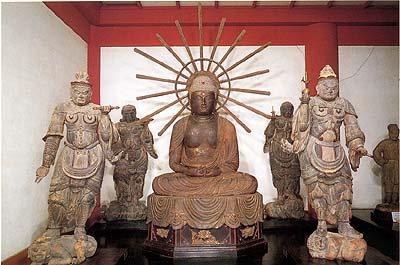
Photo source: Kanzeon-ji temple
Amida And Shitenno
Kanzeon-ji, Dazaifu

Photo source: Kanzeon-ji temple |
Amida And ShitennoKanzeon-ji, Dazaifu |
Amida, the savior Buddha, is surrounded by four Shitenno (directional guardians.) A cocked-hip posture is normal in representing the Shitenno, but seems exaggerated here to the point of unbalancing the figures. The sculptures are made of wood, and are larger than life-size (about 7 1/2 feet tall). They date from the Late Heian period. This was the central group of sculptures in the Amida Hall, before removal to its present location in the Treasure Hall.
The provenance of a statue is determined by combining stylistic and technical analysis with written documentation. In this case, it is known that a large image of Amida was dedicated in the temple in 1143. Stylistic analysis of the face and robe is consistent with such a date, and further suggests a provincial location (Fukuoka) for the sculptor. However, confirming records have not been found within the body of the statue itself.
Stylistic analysis can be useful in determining the age of a statue, although one must always be alert for archaisms (deliberate imitations of older style). For purposes of dating and attribution, many statues in Japan are associated with detailed temple records and traditions. It is helpful that sculptors were the most prestigeous craftsmen in medieval Japan (unlike medieval Europe, where they were considered inferior to painters), so their names and activities tend to be well documented. Most usefully, written records, which might include details of production, the name of the sculptor, and even the exact date when the statue was dedicated, were often placed as a kind of offering inside the hollow body of the statue. In this way a surprising amount of information is known about sculptural lineages in Japan, even from a thousand years back in time.

|

|

|